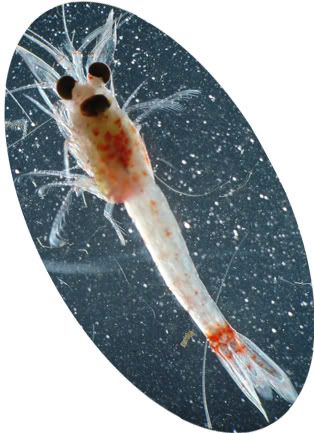Boom. Done.
But until that day when my imaginary, nightmare solution comes along, we walk a tightrope maintaining balance with the Great Lakes ecosystem.
One bit of potentially good news is the very recent invasion of the bloody red shrimp. 2006. The shrimp invaded in 2006:
The Great Lakes are facing another invader -- the bloody red shrimp -- but research suggests the crustacean interlopers could serve a useful purpose.
Mike Yuille, a researcher at Queen's University in Kingston, Ont., says the shrimp, named for their bright red spots, may become a new food source for native fish.
He says the shrimp, about the size of a thumbnail, tend to swim in swarms that can look like "red clouds" and are often seen during the day near shore areas.
Read more: http://www.ctv.ca/CTVNews/SciTech/20111124/bloody-red-shrimp-invade-great-lakes-111124/#ixzz1ehAVByH0

Turns out this new invader may be providing a new bottom-of-the-food-chain food source for smaller predators like yellow perch. It works a little bit like this:
1. For ten thousand years the base of the food chain in the Great Lakes has been a tiny shrimp called diporea. It was once the dominant biomass in the Great Lakes. The great thing of diporea is that it's an energy dense little shrimp easy for the fish to eat.
2. Zebra mussels moved in from the Black Sea and Caspian Sea without any native competitors for food and sucked up all the food that the diporea used to eat, collapsing the population of diporea. Fish then had to turn to eating small zebra and quagga mussels, which are much MUCH less energy dense than diporea.
3. Enter the bloody red shrimp (2006). Also introduced to the Great Lakes via foreign ballast water, exactly like zebra mussels. Once again it's an energy dense food or native fish.....AND...it's ALSO from the Caspian Sea and Black Sea, so it's evolved over the millennia to naturally compete with zebra mussels. So far, there's mounting evidence that the fish are eating the shrimp as they spread.
The “bloody-red shrimp” Hemimysis anomala, was first reported in the Great Lakes by NOAA from samples collected in Muskegon, Michigan in November of 2006 in waters connected to Lake Michigan. It is a small shrimp-like crustacean (order Mysidacea) native to the low-salinity margins of the Black Sea, the Azov Sea, and the eastern Caspian Sea and most likely was brought into the Great Lakes via ballast tanks. However, mysids are also used by aquarists as a high-nutrition food for aquarium fish, although we have not found any records that Hemimysis is used this way.
And incidentally, it turns out Muskegon Lake was where the bastards were firs discovered..a fact I just learned about just now on the NOAA website...weird....
The main Muskegon population was found in a swarm of over 300 individuals per m3. It has also been found in samples taken in Lake Ontario off Oswego, New York. In both locations, adults, juveniles, and pregnant females were found, indicating that this species is reproduction in the Great Lakes.
As I've mentioned before, the Great Lakes are a managed eco-system. Because of a constant barrage of invasive species for most of a century, the Great Lakes are no longer a naturally balanced eco-system. The Great Lakes Fisheries Commission and state level natural resources departments fight year after year after year to maintain an ecological balance. We'll never be able to go back to what the Great Lakes were. We can, at best, maintain a system that we want.
Let's hope that the bloody red shrimp help the system maintain a balance.
No comments:
Post a Comment